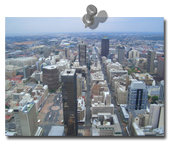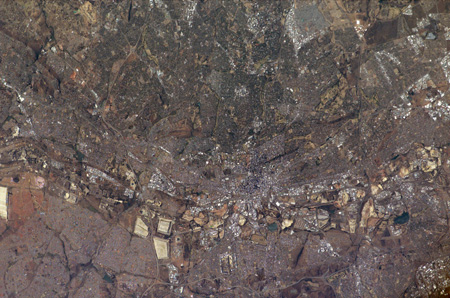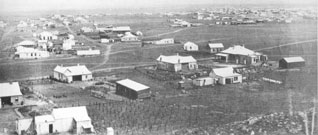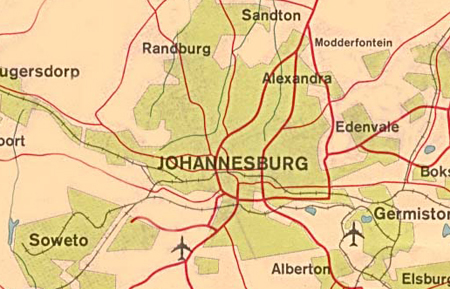Johannesburg

Source: Wikimedia
Johannesburg has a population of nearly 4 million people. It is estimated that the city grew 4% per year in the late 1990s. Some growth scenarios see metropolitan Johannesburg reaching almost 15 million people by 2015. The city was founded in 1886 and is therefore one of the youngest major cities in the world (Joburg.org, The Urban Age Project).
The city literally erupted into existence and rapidly urbanised with the exploitation of large deposits of gold. It grew up on the edge of goldfields. Johannesburg today is the product of a set of circumstances that are highly specific to Africa: with history as a British colony and tight relation to the apartheid regime, the city is now a melting pot for a new kind of Africa, and is growing rapidly as a commercial, banking city.

Source: NASA Visible Earth
The center of Johannesburg is the fine-grained pattern (created by shadows cast from the high rise buildings in the city) in the centre of the image above.
On the southern fringe of Johannesburg is a line of light colored, angular patches stretching across the scene. These patches are the great "mine dumps", the crushed rock that remains after gold extraction from numerous gold mines. Some mine dumps are so large that an outdoor movie theatre was located on one of them. Neighbouring industrial cities are nestled among the mine dumps as far as the edges of the photograph.
The green zone (top right) is the leafy northern suburbs, where hundreds of square miles of grassland have been progressively forested since Johannesburg was founded in 1886. Small light patches within the tree-rich zone are satellite businesses and shopping centers, typical of any big western city.
By contrast, a major ghetto (established by the former South African government) typical of developing-world urban migration, appears as the grey zone lower left (the famous Soweto Township). Soweto appears largely treeless except for protected valley bottoms(NASA).

Source: Wikipedia
As the description of the image shows, Johannesburg is clearly segregated spatially, each race group living in its own residential communities separated by green belts with carefully planned employment sites and transport.
Sandton, now the heart of its financial and corporate life, was a site of country estates and recreational activity for the wealthy Johannesburgers in the early twentieth century. The city presents itself as Africa's "world class" metropolis (Bremner 2007, Sudjic 2007).

Source: University of Texas
Johannesburg, like other African cities can't be as easily categorised as European cities, because different developments and circumstances are interconnected. 22.7% of the total population are aged 14 or younger, and only 4% of the population reach the age of 65. In Johannesburg, despite 600 gated communities, enforced by 1,100 checkpoints, 24.1% live below the poverty line. Tragic drops in population are caused by the appalling mortality of HIV/ AIDS and tuberculosis. In addition, the city puts great importance on symbolic events, particularly the 2010 Football World Cup (Bremner 2007, Sudjic 2007)
Quotes on Gated Communities in Johannesburg:
- "Johannesburg is a city in which the malls and gated communities typically associated with southern California have been given their most baroque (pronounced) ".
- "In some ways, Johannesburg's gated settlements, literal re-creations of medieval walled cities, could be seen not as a reflection of American suburbs, but as predictions for what they may one day be like" (Sudjic 2007).
Task: 1. Draw a sketch of the photograph to identify and annotate different landcover zones.
2. Find related pictures of the various locations mentioned
on the internet.
3. Compare the astronaut photograph with the image of Johannesburg in 1896 and with the map above. Can you locate the different parts of the city on the astronaut's photograph?
